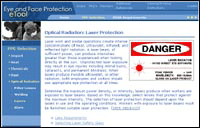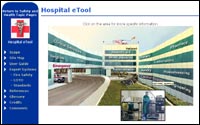 |
Safety and Health Topics |
|
| Non-Ionizing
Radiation |
|
|
|
 |
In
Focus |
 |
|
|
Non-ionizing radiation is described as a series of energy waves
composed of oscillating electric and magnetic fields traveling at the speed of
light. Non-ionizing radiation includes the spectrum of ultraviolet (UV), visible
light, infrared (IR), microwave (MW), radio frequency (RF), and extremely low frequency
(ELF). Lasers commonly operate in the UV, visible, and IR frequencies. Non-ionizing radiation is found in a wide range of
occupational settings and can pose a considerable health risk to potentially
exposed workers if not properly controlled.
This page provides links to technical and regulatory information on the control of occupational hazards from non-ionizing radiation.
|

|
Extremely
Low Frequency Radiation (ELF)
Extremely Low Frequency (ELF) radiation at 60 HZ
is produced by power lines, electrical wiring, and electrical equipment.
Common sources of intense exposure include ELF induction furnaces and high-voltage power lines. |
 |
Radiofrequency
and Microwave Radiation
Microwave radiation (MW) is
absorbed near the skin, while Radiofrequency (RF) radiation may be absorbed throughout
the body. At high enough intensities both will damage tissue through heating.
Sources of RF and MW radiation include radio emitters and cell phones. |
 |
Infrared Radiation
(IR)
The skin and eyes absorb infrared radiation (IR) as heat. Workers normally
notice excessive exposure through heat sensation and pain. Sources of IR
radiation include furnaces, heat lamps, and IR lasers. |
 |
Visible Light Radiation
The different visible frequencies of the electromagnetic (EM) spectrum
are "seen" by our eyes as different colors. Good lighting is
conducive to increased production, and may help prevent
incidents related to poor
lighting conditions. Excessive visible radiation can damage the eyes and
skin. |
 |
Ultraviolet
Radiation
(UV)
Ultraviolet radiation (UV) has a high photon energy range and is particularly hazardous because there are
usually no immediate symptoms of excessive exposure. Sources of UV radiation include the sun, black
lights, welding arcs, and UV lasers. |
 |
Laser
Hazards
Lasers typically emit
optical (UV, visible light, IR) radiations and are primarily an eye and skin hazard. Common
lasers include CO2 IR
laser; helium - neon, neodymium YAG, and ruby visible lasers, and the
Nitrogen UV laser. |
 |
What
additional information is available?
Related Safety and Health Topics Pages | Training | Other Resources |
 |
In Focus |
 |
 |
eTools
 Eye and Face Protection. OSHA. Provides a comprehensive hazard assessment,
information about selecting protective devices for the workplace, as well as
OSHA requirements.
Eye and Face Protection. OSHA. Provides a comprehensive hazard assessment,
information about selecting protective devices for the workplace, as well as
OSHA requirements.
-
 Hospital. OSHA. Focuses on some of the hazards and controls found in the
hospital setting, and describes standard requirements as well as recommended
safe work practices for healthcare workers.
Hospital. OSHA. Focuses on some of the hazards and controls found in the
hospital setting, and describes standard requirements as well as recommended
safe work practices for healthcare workers.
|
|
|
|
|
|
|

